Head for Kindergarten Teacher Education
Professor, University of Helsinki, Department of Applied Sciences of Education
Panelist: Bernard Spodek
President of Pacific Early Childhood Education Research Association
Professor Emeritus, University of Illinois of Urbana-Champaign
Coordinator: Yoko Shirakawa
Professor of Early Childhood Education, Konan Women's University
Shirakawa: This is the fifty-third Child Study Symposium at International Child Study Center, Konan Women's University. Let me first introduce today's presenter professor Ojala. He will talk about educational reform and early childhood education and care in Finland. Then, I will introduce Dr. Spodek as a panelist who is sitting over there. And Mrs. Spodek is also joining this symposium. Mrs. Spodek had worked as an elementary school teacher for many years.
Professor Ojala: Good afternoon, ladies and gentlemen. First, I would like to thank for invitation visiting here and for professor Shirakawa and Konan Women's University. Thank you very much for invitation.
Something about me, I am teaching and making research in my university for kindergarten teacher education, but also for primary school teacher training. That is, my special interest is transition from kindergarten to school.
Here you can see a picture of typical day care center (kindergarten) in Helsinki, Finland during winter time. You can see that most of our centers (kindergartens) are quite new because we have created the day care system after 1973. And after that it has been very rapid increase for kindergartens and that why we needed to build new kindergartens.
Now I will introduce you to Finnish early childhood education. Here you can see the description about educational system in Finland. The school is starting in Finland at the age of seven and that is very late. Internationally you can not find many countries that start obligatory schooling so late.
Before the school there are two periods for early childhood education. Just before the school, there is so called preschool which is one year intensive preparation for the transition to school.
Slide l (Enlarge)
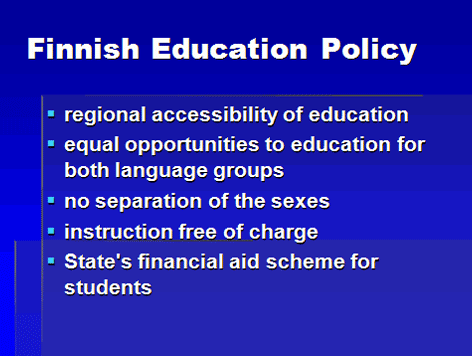
Slide 2
And before the preschool there is Early Child Education and Care (ECEC) organized mainly in day care centers. We called daycare centers as kindergartens earlier, because our system was a little different and the new name is now the day care center, main institute where the children are before the school.
In Finland the educational policy is very important and is guided by government and we know precisely which type of new trends in each year is coming into the educational policy.
Here we can see the main items for educational policy right now and in near future. Finland is the country which has a lot of land and space. For this reason one important issue is that everywhere in Finland daycare centers and schools must offer qualitative educational services.
One important issue is that we have in Finland two language groups which are official, Swedish and Finnish. We have as minority the Swedish speaking population about six percent and it's the law that you can use both languages everywhere e.g. day care centers, schools, universities.
Then we have the gender issue. Nowadays there is an increasing attention that the both sexes, that means boys and girls, man and woman must be educated equally, and there cannot be separation in a society based on the gender.
The next important policy issue is that until now instruction and general education are free of charge. This means that education is offered for everyone without paying anything.lt is starting before the school and includes the school system, even universities nowadays, all this is without any kind of payment. And finally, when we have university or polytechnic students and when they study the state is giving extra money that they can live during the study time in the city. This is not too much but is enough for living and accommodation.
We have also more detailed policy issues for developing our educational system.
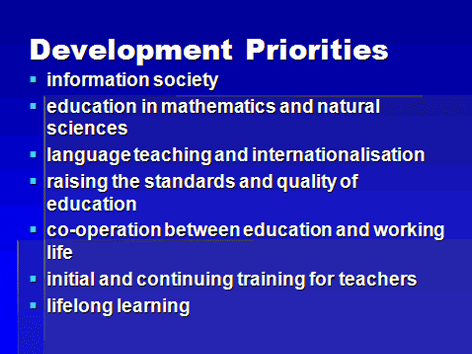
Slide 3
Right now there is an intensive developmental work in these issues. First, we would like to be a leading country in information society like Japan and many other countries.
That's very important for our school systems starting from day care (kindergarten) level and everywhere in Finnish society you can see signs about high technology industry and innovations. That's also a formal issue for our government.
Second, nowadays in school subjects and may be a little bit in day care (kindergarten) education there is new attention to mathematics and natural science. This international issue is coming more and more important and we have a lot of new research and in-service training for teachers, for example, in mathematics. And now early mathematics is under very intensive development.
For most European countries which are small, the other languages are very important. Nowadays English is the first foreign language but after that children can learn other foreign languages like Spanish, Italian, French, Russian and etc. and these are learned in school. In the university the students must read English textbooks for the examination.
Nowadays we have more and more under discussion and also action that we must raise the quality, control the quality and have standards for quality in different levels of public education. This type of issues is increasing and we must have feedback how our day care centers, schools and universities work, how they are functioning. We need to have more precise standards about what is good quality.
Then I will go to the next issue: Initial and continuing training for teachers. For kindergarten teachers and teachers in primary school there are now possibilities that in each year they are trained to keep their competence. They can have free time from school and free time from day care centers when they are trained. The law says that they must have certain days for in-service training during the year.
Slide 4 (Enlarge)
As a summary I will present the main structure of the ECEC system for children aged 0-6 in Finland. By using this complicate figure I explain a little bit about it. Our school begins at the age of seven. Here you can see the main strategy for educating children before the school age. Let us start with the municipal day care center. This is the main educational institution of day care system. Municipal day care has two main forms: family daycare and daycare center. And then comes the preschool education for six-year old as I told. Later I will show you how many percentages of children are cared for municipal day care center, private center and other facilities. The third main type of education and care for children before school is that children can stay home for the first three years. Parents can be liberated from work and stay at home and the state is giving money as compensation because they cannot work and family must live. The number of children from 0 to 3 year-old under this type of home care system is nowadays increasing rapidly because it's a new possibility. Also the private sector is possible in day care but it is very small now. In practice every facility is public but there is possibility that if parents want and there are attractive options for private day care, it is possible to select that and the state is also giving some money those who run the private center.
Shirakawa: Who runs the private center? A company or?
Professor Ojala: E.g. An association of two or three kindergarten teachers can run the private day care center. Usually they work as a company.
These examples presented in the figure can show how our state and our system like to support families also before they have a baby and after the baby is born. When the baby is very young, usually under the age of three, many kind of support is coming from the state. There are a lot of organizations who work together to help or counsel parents having a new baby.
A new trend is that not only mothers are at home when the child is very young, but also there is now a support for fathers. Father can be liberated from work to stay some weeks at home and the payment is compensated by our government. So not only mothers stay at home but nowadays increasing number of fathers stay home with young children if they like.
Let's now look at more precisely how families select day care options. We feel it's very important that families have a lot of choices. Even the state supports very strongly children's day care there are different kind of options based on parent's decisions. It seems to be that municipal day care centers which correspond your kindergartens in Japan are the most popular place where children are cared for before the school. But also the family daycare is quite popular especially when children are very small. There are families who like to care their children in home-like environment. Some other person is taking care of children but environment is like private home.
Next I will speak about child home care. This means if the parents like to stay home when children are under three, the state is supporting them by giving some money. This possibility is quite popular nowadays because twenty-six percent of children are under this type of early childhood care and education before the age three.
Here you can see more precisely how many percentages of children are in day-care center and family day care. You can see that day-care center is the most popular and family day care is also quite popular. You can also see that only twenty percent of children under three-year-old are in public day care center and it means that the rest of children are more or less under home-type care which is supported also by the state. When the children become older the amount is increasing. Almost all day-care is organized as a full-time care and usually children stay daily in day care center for seven to eight hours.
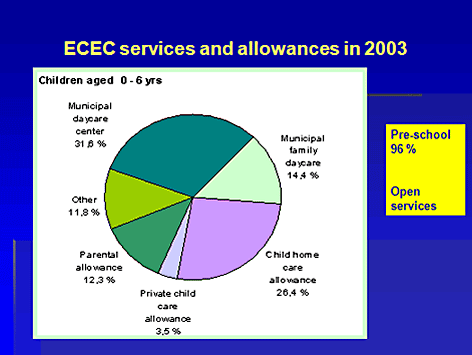
Slide 5
Here you can see how the number of children is increasing in public and private day care according to the age of children. When the children are very young the number is very low because children are cared for home-like environment. And when preschool year comes one year before school, almost all children (96.3%) are in one type of early childhood education, it means in pre-school education.
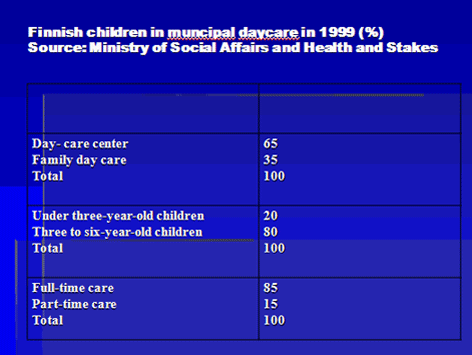
Slide 6
Next, I can show you comparative statistics from Europe and you can see that the Finnish early childhood education is very different from other European countries. Take the example from Italy. When children are young at the age of three, almost all these children go to pre-school, that is the same as kindergarten in your country and day care centre in Finland. But in Finland only 36 percent of children are in public day care center and private day care center and the rest are cared for in a family type orientation. The number of children is increasing slowly until the children are six years olds and at this age we have corresponding percentages of children compared with other European countries.
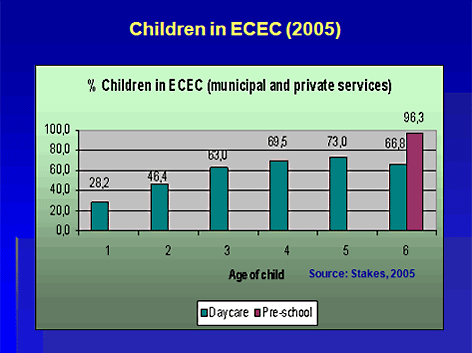
Slide 7
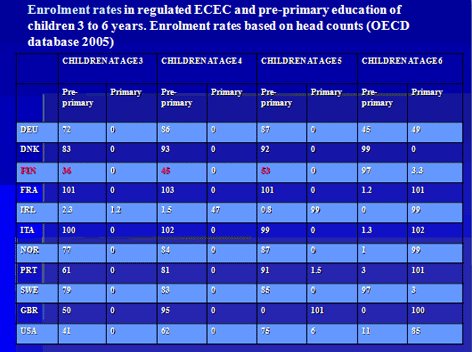
Slide 8
Now I will talk about our new educational guideline for educating children from age one to five, ages before the pre-school. In this educational guideline we have started discussing about educational values. I will take some items. The first one is non-discrimination and equal treatment. It means that in whole Finland there must be same kind of opportunity and high quality service everywhere and all these formal day care options can be used everywhere and for every family if they like. The next example is associated with views about children. The message is that we must listen to small children, how they like to experience learning in day care center (in kindergarten) and what they like to learn. There is a new attention that we must respect even small children, and listen to what kind opinions they might have. The third example is that the special support is very important. If the children have problem for future learning or behavioral problem, it is important that during the early childhood years, she or he can receive all support day care center (kindergarten) can offer with experts working in co-operation with day care center.
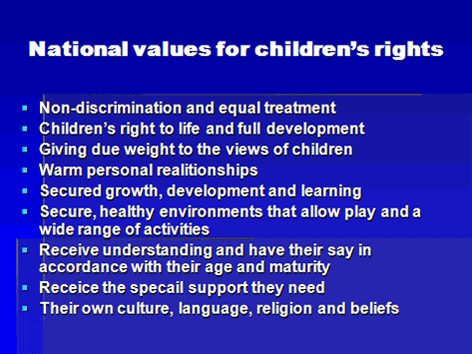
Slide 9
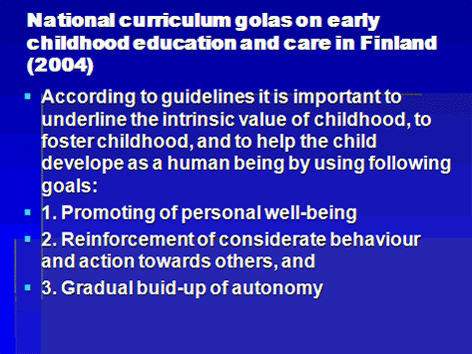
Slide 10
The new curriculum for children from age one to five is a new pedagogical tool in Finland. It is only three years since we had this new national curriculum. I will point out some important conceptions which are guiding all the education and care activities for children between one and five. One important issue is a general well-being of children. We don't stress so much that children must learn reading, writing and mathematics and certain kind of skills very early. More important is the general well-being. The second important thing is the social interaction. And the third important general educational guide is that we must educate children toward autonomy and independence in their behavior and learning.
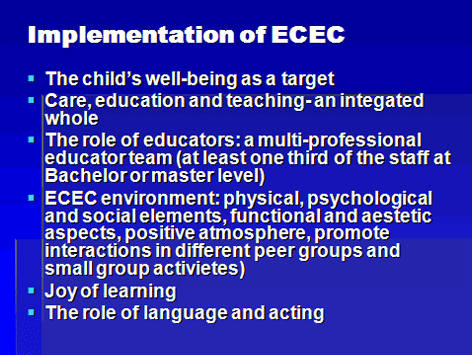
Slide 11
In this curriculum we have also guidelines how to implement general goals. I will pick up some examples. Let's see e.g. the joy of learning. This is one important issue when we organize education and care for small children. The message is that we focus more on joy of learning and interest for learning than serious learning for achieving specific curriculum targets.
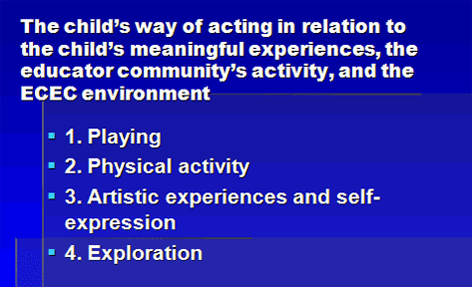
Slide 12
What kind of pedagogy is proposed when implementing the ECEC curriculum? There are four important pedagogical activities which are suggested. The first one is playing. That means play oriented learning. The second is physical activity. Inside the day care center children do many types of motor and musical activities. Other important are artistic activities such as music, painting and etc. The fourth suggested activity is free exploration inside the kindergarten and outside.
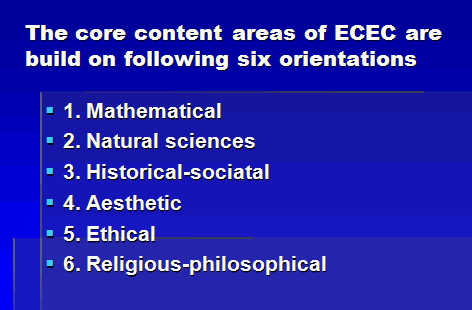
Slide 13
We have a new conception used in ECEC curriculum, because the school is waiting to children with school subjects and also the preschool year is coming at age of six. This conception is orientation. During the years from age one to five there is a pedagogical orientation to curriculum contents or academic subjects. According to the ECEC guidelines children must have an orientation to mathematical knowledge, natural science knowledge, historical-societal knowledge, ethical and religious-philosophical knowledge. These are the content areas during ages one to five.
Now I will talk about preschool education. You must understand that preschool education curriculum is very new in Finland. Only since 2000 we have had specific curriculum for children just before the school including guidelines for intensive preparation to school start. Let's keep in mind that we have two curriculums before the school, curriculum for the children from one to five-year-old, and the specific curriculum for the children just before the school.
At the end I will take only some examples about preschool curriculum because we must finish in a minute. One important principle in this curriculum is that the pedagogy must be organized so that it corresponds equally special needs of boys and girls. You must create, as a teacher, activities which are intensive for learning of boys and girls. That is very important new principle.
Shirakawa: You mean that boys' needs and girls' needs are different?
Professor M. Ojala: Yes, teachers must take account. Teachers must organize activities so that boys are interested in and girls are interested in.
Shirakawa: So the activities must be organized differently for boys and girls?
Professor M. Ojala: Sometimes differently, sometimes using same activities. Usually both. Yes, it's difficult.
The last principle to be mentioned as an example before I finish is following: when children are in preschool it is very important that all the activities must be organized to support positive self conception of the children. There is also an important aim that children should become interested in learning new things and go to school. Interest for learning and strengthen learning ability and positive self-conception for learning. These are important.
This was all I was able to speak in my presentation. I hope that we can now discuss about these issues more deeply and you perhaps can read more information about Finnish ECEC and preschool. Thank you for giving me an opportunity about this presentation.
Shirakawa: Thank you very much, Professor Ojala. Well, we would like to welcome the next speaker, professor Spodek as panelist.
Professor B. Spodek: Konnichiwa! First I would like to thank all the people in Konan Women's University for inviting me today. This is the second time I've been to this university. First time was three years ago, and the students' population of the university has grown a great deal since that time.
I was asked to discuss Professor Ojala's paper. While I was given a very short time in the program, we could spend weeks talking about each of the content areas that Professor Ojala raised. So I would like to just point out a few issues that I think are important to people in Japan as well as to people in the United States. Remember, what I say is from the perspective of an American who has visited Japan several times.
Dr. Ojala's paper describes the age of children when they begin compulsory primary school in Finland. Children start formal schooling at the age of seven in Finland. This is older than the beginning school age of children in most of the countries I know. More often children start primary school at the age of six and sometimes at the age of five years. Interestingly, if you look at the OECD study that came out earlier this year, the Finnish children come out on top in terms of academic achievement at the end of their primary school education when compared with children from other countries. So starting school at a young age does not mean you will be more successful.
There are six additional points that Prof. Ojala made that are important when we compare education in Finland with education in Japan or in the United States.
The first is the relationship between day care or child care and early education or kindergarten. I was in Japan three years ago, participating in a conference on the relationship between early education and child care. Among the things I talked about was the concept of educare that people in America are starting to use -- the idea that child care and early education could be combined into the same service. We find this type of service in Finland and in other Nordic countries. I was told by a major speaker at this conference that such a combination would never happen in Japan. However, it is very successful in Finland and in other Scandinavian countries as well. In Iceland, for example, young children are provided not with kindergarten or preschool or child care, but with play school. It is a play-based education for young children. Children may attend these programs for a half-day or for a full long day since they offer both education and care.
Another issue in Professor Ojala's presentation relates to who goes to kindergarten or day care. In Finland everybody has the right to attend a program and parents can choose what kind of program their children will attend. In America, very often enrollment in a preschool or child care program depends on who can afford to pay the fee for the program. Parents who can afford the fees can send their children to any program, for most programs are private. The public is only now beginning to support early childhood education for children below age five as part of the public schools. There are government supported programs like Head Start provided for poor children and there are preschool programs for children with disabilities in the United States. More recently, states are providing prekindergarten programs for all children in the public schools.
A related issue is who pays for a child's early childhood education. In Japan, whether a child goes to a public kindergarten or a private kindergarten the family must pay a fee. In America children who are age five and possibly those who are age four who go to public kindergarten or prekindergarten do not pay a fee, but those who attend day care or preschool before kindergarten must pay the fee. In Finland early education is free to families and paid for out of tax funds.
In Finland the preparation of early childhood teachers includes both pre-service education (before teachers are employed) and continuing or on-going education. All the teachers in day care center, preschool and kindergarten have degrees from universities. In America teachers in public kindergarten have at least a four-year bachelor's degree but those in day care centers may have very little education. In Japan, junior colleges and four-year universities prepare kindergarten teachers. Both teachers with two-year-preparation and teachers with four-year-preparation can be in kindergarten.
The next issue that interests me relates to the curriculum of the kindergarten. Unfortunately, we couldn't go into the specifics here. There is no national curriculum in the United States. There are state curriculums but they are very general. In Japan there is a national curriculum for kindergarten. When it changed some years ago, there was a concern about the requirement for "expression." Kindergarten children and kindergarten teachers did not know exactly what meant and there was much discussion. Aesthetic expression is very important in the Finnish.
The sixth point I want to talk about is relation of preschool, child care and kindergarten to the elementary school. In Finland there is a concern now about the transition that children make. During the last year, when children are six year old, a special program is provided to help child move from kindergarten and day care center into the elementary school. In America, where the kindergarten is for five-year olds, it is a part of elementary school -- a special class but it is in the same building. In Japan, there is a separation between kindergarten and elementary school and children are often protected from the influence of elementary school on the kindergarten. The kindergartens support a great deal of play, but they don't provide the transition to the elementary school that may be necessary for children.
A final point I want to make is that I was impressed with the priorities of early childhood education in Finland that were described by Professor Ojala. There are universal priorities that early childhood educators have in many countries around the world. In China, Japan, England, Australia and United States, you find the same priorities. The differences are not in priorities themselves but how these priorities are implemented from country to country and from culture to culture. There we see differences between one nation and another.
Thank you for giving me an opportunity to make my simple remarks in relationship to a very complicated and important document.
Shirakawa: Thank you, Dr. Spodek. Now, it is the question time. Students will leave this room at two and a half. So I will receive some questions from students.
Student A: I came from different university to listen to the lecture. My question is professor Ojala talked about the two languages used in Finland, and what languages were spoken in Finland?
Shirakawa: The two languages are Finnish and Swedish. Native language is Finnish, but there is six percent of Swedish people in Finland and they speak Swedish. Is this all right, Dr. Ojala?
Professor M. Ojala: Yes, that is right. And in every school and university they must use these two languages for teaching if there are students whose mother language is different from Finnish.
Student B: My question is how far fathers in Finland participate in child rearing. How many fathers take parental leave in Finland?
Professor M. Ojala: Yes, fathers take parental leave for one month. Fifty to sixty percent of fathers take that opportunity to leave from work. And mothers usually take one year leave outside from the work.
Professor B. Spodek: Fifty to sixty percent of fathers, not like Japan!
Student C: Why does the state support child care and education so much in your country?
Professor M. Ojala: Children are our future. Very simple.
Professor B. Spodek: Japan is concerning that the number of children been born keeps going down, down, and down, maybe, if Japan accept the similar policy to give mothers time off from work, then more children would be born.
Student D: How many children within a family in Finland?
Professor M. Ojala: One point seven. About two children in a family, less than two.
Student D: Even though the state support system for child rearing is sufficient, then why so few children? Why not more because the support is so big?
Professor M. Ojala: Yes, it is a good question. Why not more? It's a very difficult question! And it's a good question. When the living conditions are better, at the same time the number of children is lower. It's everywhere in industrialized countries. It's surprising in some way. I don't understand. It is a big problem because we don't have enough labor force, and so in future we must have workers coming from other countries to work in Finland because the birthrate is so low.
Student E: In Japan it is very difficult for women to keep working while taking care of her children. Is it easy in Finland?
Professor M. Ojala: Yes, in Finland we have a law that when you have a small baby, you can stay home for three years but the employer must keep the position and the possibility to continue the same work.
Student G: When children are sick or have some diseases and can not go to school or child care center and need to be hospitalized for a long time, is there any special system to help these children in your country?
Professor M. Ojala: In every hospital there is special school and care center (kindergarten) for children who need to stay longer there. Teachers there have the diploma of special teacher in addition the general teacher diploma. It's a good question.
Student H: Why don't you have women's university in Finland?
Professor M. Ojala: As I talked about the educational policy, there are equal opportunities for girls and boys, for women and men, so we do not have special school, or colleges and universities only for girls or women. Earlier we had separate high schools for girls and boys.
Student I: I hear that your country has a good social welfare system and I have learnt that state pays lots of allowance when mothers stay home while her child is under the age three. It must be much money, and I wonder maybe tax is high. How much tax do you pay?
Professor M. Ojala: Thirty-five percent income tax in average and I pay forty percent income tax. Besides, sales tax is twenty-two percent.
(Students.... Wahoo!)
Shirakawa: There seems to be more questions, students are so much interested in this symposium, but unfortunately students need to leave for the next session. Thank you very much professor Ojala and thank you very much, professor Spodek.
This article was reprinted from Child Studies, Vol. 10, March, 2008, International Center for Child Studies.
Child Research Net would like to thank Prof. Mikko Ojala, Prof. Bernard Spodek, Prof. Yoko Shirakawa and International Center for Child Studies, Konan Women's University (Kobe, Japan) for permitting reprinting of this article on the CRN web site.














